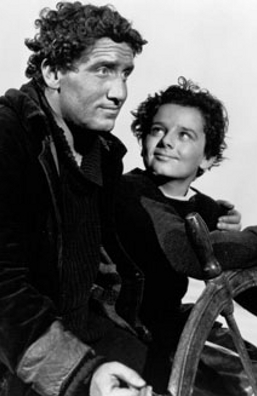By Mary
Claire Kendall
 |
| Gary Cooper publicity photo for Morocco (1936) |
Like Spencer
Tracy, Gary Cooper and John “Duke” Wayne.
“It’s odd how many of these immortals of the silver screen of the firmament,” he said, “need only one name to conjure the gestalt of their great artistry. In women, it’s names like Garbo, Hepburn, Stanwyck, Loren. With men it’s Bogart, Cagney, Gable. Now you can chuck in the ones, who combination punch, of Gary Cooper or John Wayne. But a solo tag is the norm. Brando, Clift, Poitier, McQueen, Hoffman, DeNiro, Pacino… The list is finite. The club is exclusive…”
Spence, Coop and Duke are three “immortals of the silver screen of the firmament.” And, they tower.
 |
| Spencer Tracy and Freddie Bartholomew in Captains Courageous (1937) |
Duke, for
his part, won an Oscar for True Grit (1969),
which premiered 10 years to the day before his death on June 11, 1979. Like
Denzel, he also received the Cecil B. DeMille Award.
Of course,
Hanks’ oversight was, no doubt, inadvertent—no disrespect intended—even though
he failed even to mention Tracy, considered by his peers to be the greatest
actor Hollywood had ever seen. In addition to his wins, he garnered seven more
Best Actor nominations including, posthumously, for Guess Who’s Coming to Dinner (1967).
The trio,
like so many stars in the silver screen’s firmament, deserves respect.
 |
| John Wayne in Wake of the Red Witch (1948) |
Then
there are the living legends which, not two weeks after Hanks’ Golden Globe
oversight, were disenfranchised by the Academy as part of its misguided effort
to redress, by ‘widening its nets,’ the Academy’s collective failure this year
to nominate any African American stars for an Oscar. (Though many like George
Clooney rightly note the problem lies with the pipeline.) If these members are
inactive for 10 years and do not meet certain criteria, their status will be
changed to “emeritus” with all the privileges of Academy membership—except
Oscar voting.
Not so
fast, says Academy member Mother Dolores Hart, known for Wild Is the Wind (1957), King Creole (1958) and Oscar-nominated God Is The Bigger Elvis (2012). These
older members, she said, are the “wisdom figures.” And, when the Academy loses
them it “is going to destroy something of the essence of how people look at” it
and “the quality” with which they associate it. “It’s always been the
star in the sky” among all the guilds. “And, I think they are going to lose
that.”
| Elvis Presley and Dolores Hart in King Creole (1958) |
Mother
Dolores was brought out of retirement in 1998 by Oscar-winner Karl Malden, then
president of the Academy. In 1963, at the end of the Come Fly with Me press junket, her limousine’s final destination
was the Abbey of Regina Laudis in Bethlehem, Connecticut, where she has lived
in consecrated life for 53 years. “We want to hear what you say and what you
experience, because you have experienced it from a different place,” she said
Malden told her when he called.
“I think
they should rethink this,” said Mother Dolores, “and see if there’s something
else they can offer.”
Surely,
they will come up with a solution that keeps the Academy, like the “immortals”
of the “firmament,” glistening.
No comments:
Post a Comment